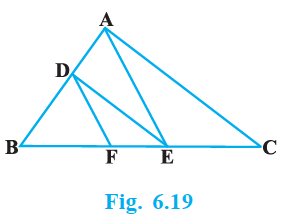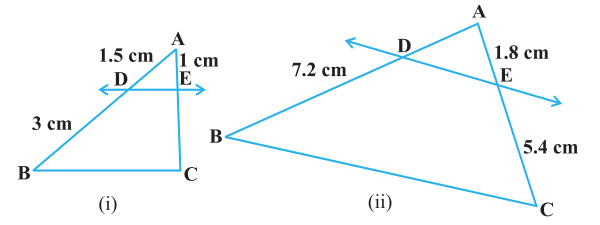
(i) Given, in △ ABC, DE∥BC
∴ $\dfrac{AD}{DB} = \dfrac{AE}{EC}$ [Using Basic proportionality theorem]
$\dfrac{1.5}{3} = \dfrac{1}{EC}$
EC = $\dfrac{3}{1.5}$
EC = $\dfrac{3 × 10}{15}$ = 2 cm
EC = 2cm
(ii) Given, in △ ABC, DE∥BC
∴ $\dfrac{AD}{DB} = \dfrac{AE}{EC}$ [Using Basic proportionality theorem]
$\dfrac{AD}{7.2} = \dfrac{1.8}{5.4}$
AD = $\dfrac{1.8 × 7.2}{5.4} = (\dfrac{18}{10})×(\dfrac{72}{10})×(\dfrac{10}{54}) = \dfrac{24}{10}$
AD = 2.4
Hence, AD = 2.4 cm.
E and F are points on the sides PQ and PR respectively of a Δ PQR.
For each of the following cases, state whether EF || QR :
(i) PE = 3.9 cm, EQ = 3 cm, PF = 3.6 cm and FR = 2.4 cm
(ii) PE = 4 cm, QE = 4.5 cm, PF = 8 cm and RF = 9 cm
(iii) PQ = 1.28 cm, PR = 2.56 cm, PE = 0.18 cm and PF = 0.36 cm
Given, in ΔPQR, E and F are two points on side PQ and PR, respectively. See the figure below
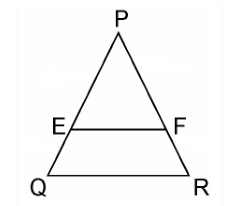
(i) PE = 3.9 cm, EQ = 3 cm, PF = 3.6 cm and FR = 2.4 cm
by using Basic proportionality theorem
find $\dfrac{PE}{EQ}$ and $\dfrac{PF}{FR}$
$\dfrac{PE}{EQ} = \dfrac{3.9}{3} = \dfrac{39}{30} = \dfrac{13}{10} = 1.3$
$\dfrac{PF}{FR} = \dfrac{3.6}{2.4} = \dfrac{36}{24} = \dfrac{3}{2} = 1.5$
$\dfrac{PE}{EQ} \neq \dfrac{PF}{FR}$ , EF not Parallel QR
(ii) PE = 4 cm, QE = 4.5 cm, PF = 8 cm and RF = 9 cm
by using Basic proportionality theorem
find $ \dfrac{PE}{EQ}$ and $\dfrac{PF}{FR}$
$\dfrac{PE}{QE} = \dfrac{4}{4.5} = \dfrac{40}{45} = \dfrac{8}{9}$
$\dfrac{ PF}{RF} = \dfrac{8}{9}$
$\dfrac{PE}{QE} = \dfrac{PF}{RF}$ , EF is Parallel to QR.(iii) PQ = 1.28 cm, PR = 2.56 cm, PE = 0.18 cm and PF = 0.36 cm
by using Basic proportionality theorem
find $ \dfrac{PE}{EQ}$ and $\dfrac{PF}{FR}$
EQ = PQ – PE = 1.28 – 0.18 = 1.10 cm
FR = PR – PF = 2.56 – 0.36 = 2.20 cm
So, $\dfrac{PE}{EQ} = \dfrac{0.18}{1.10} = \dfrac{18}{110} = \dfrac{9}{55}$…………. (i)
$\dfrac{PE}{FR} = \dfrac{0.36}{2.20} = \dfrac{36}{220} = \dfrac{9}{55}$………… (ii)
$\dfrac{PE}{EQ} = \dfrac{PF}{FR},$ EF is parallel to QR.

In the given figure, we can see, LM || CB,
By using basic proportionality theorem, we get,
$\dfrac{AM}{AB} = \dfrac{AL}{AC}$……………………..(i)
Similarly, given, LN || CD and using basic proportionality theorem,
∴$\dfrac{AN}{AD} = \dfrac{AL}{AC}$……………………………(ii)
From equation (i) and (ii), we get,
$\dfrac{AM}{AB} = \dfrac{AN}{AD}$
Hence, proved.
In ΔABC , DE || AC
$\dfrac{BD}{AD} = \dfrac{BE}{EC}$ .........(i) [By using Basic Proportionality Theorem]
In ΔABE, DF || AE
$\dfrac{BD}{AD} = \dfrac{BF}{FE}$ ........(ii) [By using Basic Proportionality Theorem]
From (i) and (ii)
$\dfrac{BD}{AD} = \dfrac{BE}{EC} = \dfrac{BF}{FE}$
Thus, $\dfrac{BE}{EC} = \dfrac{BF}{FE}$
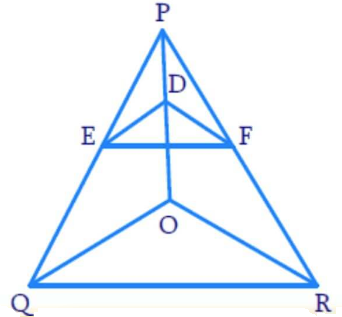
Given, In ΔPQO, DE || OQ
By using Basic Proportionality Theorem,
$\dfrac{PD}{DO} = \dfrac{PE}{EQ}$……………… ..(i)
Again given, in ΔPOR, DF || OR,
Using Basic Proportionality Theorem,
$\dfrac{PD}{DO} = \dfrac{PF}{FR}$………………… (ii)
From equation (i) and (ii), we get,
$\dfrac{PE}{EQ} = \dfrac{PF}{FR}$
Therefore, by converse of Basic Proportionality Theorem,
EF || QR, in ΔPQR.

Given,
In ΔOPQ, AB || PQ
By using Basic Proportionality Theorem,
$\dfrac{OA}{AP} = \dfrac{OB}{BQ}$…………….(i)
Also given,
In ΔOPR, AC || PR
By using Basic Proportionality Theorem
∴ $\dfrac{OA}{AP} = \dfrac{OC}{CR}$……………(ii)
From equation (i) and (ii), we get,
$\dfrac{OB}{BQ} = \dfrac{OC}{CR}$
Therefore, by converse of Basic Proportionality Theorem,
In ΔOQR, BC || QR.

Given, in ΔABC, D is the midpoint of AB such that AD=DB.
A line parallel to BC intersects AC at E as shown in above figure such that DE || BC.
We have to prove that E is the mid point of AC.
Since, D is the mid-point of AB.
∴ AD=DB
$\dfrac{AD}{DB}$ = 1 …………………………. (i)
In ΔABC, DE || BC,
By using Basic Proportionality Theorem,
Therefore,$\dfrac{AD}{DB} = \dfrac{AE}{EC}$
From equation (i), we can write,
1 = $\dfrac{AE}{EC}$
∴ AE = EC
Hence, proved, E is the midpoint of AC.
Given, in ΔABC, D and E are the mid points of AB and AC respectively, such that, AD=BD and AE=EC.

We have to prove that: DE || BC.
Since, D is the midpoint of AB
∴ AD = DB
$\dfrac{AD}{BD}$ = 1……………………………….. (i)
Also given, E is the mid-point of AC.
∴ AE = EC
$\dfrac{AE}{EC}$ = 1……………………………….. (ii)
From equation (i) and (ii), we get,
$\dfrac{AD}{BD} = \dfrac{AE}{EC}$
By converse of Basic Proportionality Theorem,
DE || BC
Hence, proved.
Given, ABCD is a trapezium where AB || DC and diagonals AC and BD intersect each other at O.
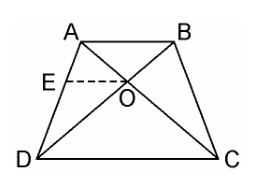
We have to prove, AO/BO = CO/DO
From the point O, draw a line EO touching AD at E, in such a way that,
EO || DC || AB
In ΔADC, we have OE || DC
Therefore, By using Basic Proportionality Theorem
$\dfrac{AE}{ED} = \dfrac{AO}{CO}$ ……………..(i)
Now, In ΔABD, OE || AB
Therefore, By using Basic Proportionality Theorem
$\dfrac{DE}{EA} = \dfrac{DO}{BO}$…………….(ii)
From equation (i) and (ii), we get,
$\dfrac{AO}{CO} = \dfrac{BO}{DO}$
$\dfrac{AO}{BO} = \dfrac{CO}{DO}$
Hence proved.
Given,
Quadrilateral ABCD where AC and BD intersects each other at O such that, $\dfrac{AO}{BO} = \dfrac{CO}{DO}

We have to prove here, ABCD is a trapezium
From the point O, draw a line EO touching AD at E, in such a way that,
EO || DC || AB
In ΔDAB, EO || AB
Therefore, By using Basic Proportionality Theorem
$\dfrac{DE}{EA} = \dfrac{DO}{OB}$……………………(i)
Also, given,
$\dfrac{AO}{BO} = \dfrac{CO}{DO}$
$\dfrac{AO}{CO} = \dfrac{BO}{DO}$
$\dfrac{CO}{AO} = \dfrac{DO}{BO}$
$\dfrac{DO}{OB} = \dfrac{CO}{AO}$ …………………………..(ii)
From equation (i) and (ii), we get
$\dfrac{DE}{EA} = \dfrac{CO}{AO}$
Therefore, By using converse of Basic Proportionality Theorem,
EO || DC also EO || AB
AB || DC.
Hence, quadrilateral ABCD is a trapezium with AB || CD.

